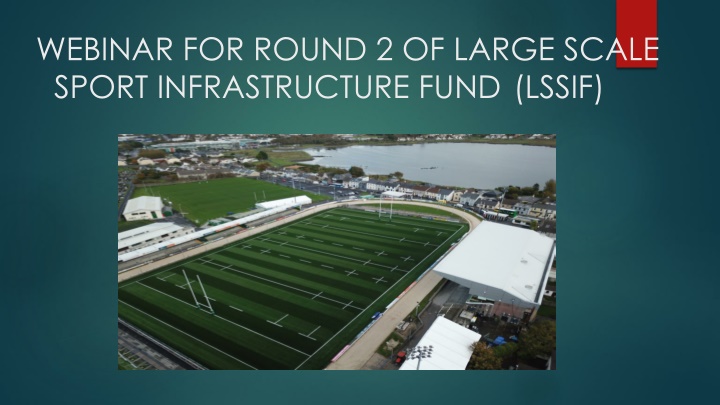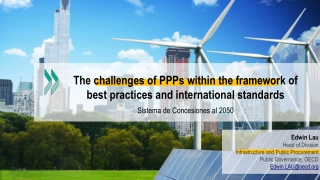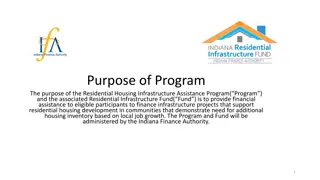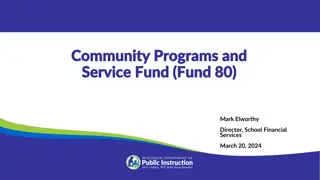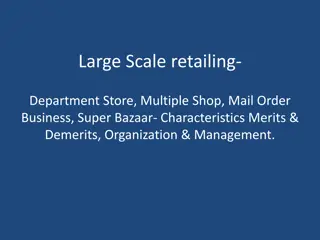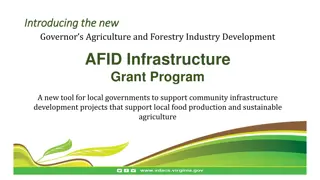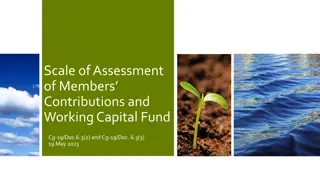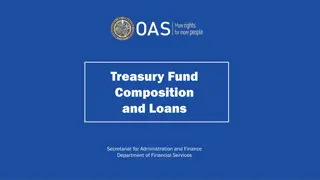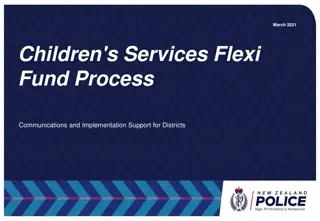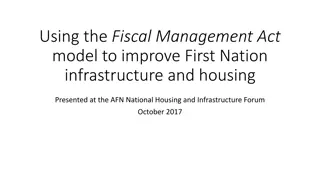Large-Scale Sport Infrastructure Fund - Round 2 Overview
"Learn about the Round 2 of the Large-Scale Sport Infrastructure Fund (LSSIF), its background, changes from the previous round, review recommendations, eligibility criteria, and who can apply. Discover the funding opportunities and guidelines for developing large-scale sports facilities."
Download Presentation

Please find below an Image/Link to download the presentation.
The content on the website is provided AS IS for your information and personal use only. It may not be sold, licensed, or shared on other websites without obtaining consent from the author.If you encounter any issues during the download, it is possible that the publisher has removed the file from their server.
You are allowed to download the files provided on this website for personal or commercial use, subject to the condition that they are used lawfully. All files are the property of their respective owners.
The content on the website is provided AS IS for your information and personal use only. It may not be sold, licensed, or shared on other websites without obtaining consent from the author.
E N D
Presentation Transcript
WEBINAR FOR ROUND 2 OF LARGE SCALE SPORT INFRASTRUCTURE FUND (LSSIF)
Background Scheme As Launched National Sports Policy LSSIF Round 1 A minimum grant of 600,000 for development. Actions 19 and 52 provide for establishment of a new Large Scale Sport Infrastructure Fund to support projects where the Exchequer investment will exceed the maximum amount available under the Sports Capital Programme The first LSSIF call closed in 2019 applications confined to local authorities and National Governing Bodies (NGBs) of Sport. Assessment of applications for funding will be considered between 600,000 and a maximum grant of 30million. The first allocations were announced in January 2020. 33 projects awarded funding. The total funding awarded to date (April 2024) under the LSSIF is 124 million.
What is different from previous LSSIF round Only One Stream Funding Available Similar Access Policy Funding available incorporates both the design and the construction element of the proposed project. There will not be a separate stream for design funding only. A provision of 120 million to the LSSIF fund for this round of applications. Similar Access Policy must be agreed upon by the organisation or the application form will be deemed invalid and will not be considered for assessment. Assessment of applications for funding will be considered between 600,000 and a maximum grant of 30million
LSSIF Review 2024 Recommendation 1: Consideration to be given to specific population and climate action/ sustainability criteria in future rounds Recommendation 2: Reduce the administrative overhead for successful applicants Recommendation 3: Level of grant aid funding required to deliver projects. Recommendation 4: LSSIF applicants will be required to set out their facility access policy Recommendation 5: Guiding Principles in respect of Stadiums and Large-Scale Sports Facilities
LSSIF WHO CAN APPLY??
Who can apply?? The scheme is aimed at .. What applicants can apply?? Joint Applications ? The scheme is aimed primarily at National Governing Bodies (NGBs) and Local Authorities (LAs) however it is also open to other bodies (including third level institutions), philanthropic funders, clubs and voluntary organisations to apply but such applications would necessarily have to be made and prioritised by a LA and/or an NGB. A solo application involving an NGB itself Joint applications are encouraged. An application that has been prioritised by both LA(s) and NGB(s) is likely to receive more favourable consideration in the assessment process. A solo application by a LA A joint application with one or more NGBs A joint application with one or more LAs A joint application involving other NGBs and one or more LAs Other bodies may also be included in any of the above combinations
NATIONAL GOVERNING BODIES (NGB) LOCAL AUTHORITIES APPLICATIONS TO THE GRANT SCHEME MUST BE MADE BY EITHER NGB OR LOCAL AUTHORITY. THIS DOES NOT PRECLUDE THE INVOLVEMENT OF OTHER ORGANISATIONS IN THE APPLICATION PROCESS, HOWEVER ALL APPLICATIONS MUST BE SUBMITTED BY AN NGB OR LOCAL AUTHORITY.
AIMS AND PRIORITIES OF THE SCHEME WHAT ARE THE AIMS OF THE SCHEME AND WHAT APPLICATIONS WILL BE PRIORITISED.
AIMS OF THE SCHEME? Increase active participation in sport (including female participation) and the quality of that participation Increase social participation in sport and the quality of that participation Improve high performance in sport Increase active participation by those with a disability Provide Similar Access to facilities to all.
What applications will be prioritised?? Projects that can be clearly identified as a Priority within a local authority s development plan and strategic vision. Priority of a NGB in its strategy for the development of active participation, social participation and improvement of high performance in the sport it governs Projects that are multi-functional in nature and cater for a number of sports and other activities. Projects that prioritise the needs of disadvantaged areas and groups including people with disabilities. Projects that provide and demonstrate a commitment and ability to manage the facility in an effective manner once capital works are completed in a financially and environmental sustainable manner.
Sharing Joint Applications Encouraged Mixture of NGBs, Local Authorities and community Facilities Sharing is compulsory for professional sports Such applications will be regarded more favourably Additional credit will be given in assessment process where formal agreements (license agreements) are in place (appendix 2 of guide)
Ineligible Projects WHAT PROJECTS ARE DEEMED INELIGIBLE ??
What projects are deemed ineligible ?? All projects that do not meet the aims of the scheme Facilities that mirror or are deemed to compete with facilities currently available, under construction or planned at the National Sports Campus are also ineligible Facilities that mirror or are deemed to compete with other national or regional facilities currently available are also ineligible.
Other ineligible project/ project costs include: Routine maintenance, minor repairs or other on-going costs (including the resurfacing of artificial pitches funded by the SCEP in the last 10 years) Operational Costs Greenways Walking Trails Legal fees Projects that have already commenced or where contracts have been signed prior to grant award Projects where the total project cost exceeds 100m Children s Playgrounds The repayment of loans The purchase of land or buildings.
Ineligible Applicants/Partners Undertakings in difficulty An Undertaking subject to an outstanding recovery order following a previous European Commission decision declaring an aid illegal and incompatible with the internal market; Applicants that are not tax compliant Applicants that remain in breach of a material provision of a previous grant agreement. Applicants that do not have a similar access policy in place. Applicants that are not in a position to establish that they either (a) own the project site or (b) have the right to undertake the proposed project on the identified site and (c) that the Department can place a charge on the site to protect its investment;
LSSIF MATCH OWN FUNDING 30% REQUIRED STATE AID
Match Funding -Available Support 30% Minimum More Favourable Assessment > 30% Match Funding can come from other schemes such as Urban Renewal or Rural Renewal Maximum Grant 30m Maximum Project Cost 100m Minimum Grant 600,000 Aid from all State sources cannot exceed the difference between the eligible costs and operating profit lifetime of investment
EU State Aid Article 55 Sport and Multifunctional Recreational Infrastructure Funding Multi Use Maximum Grant of 30m No exclusive use by Professional Sport Preferential Access where promoter funds 30% All projects must be compatible with EU Commission Regulation No 651/2014 of 17 June 2014, as amended, declaring certain categories of aid compatible with the internal market in the application of Articles 107 and 108 of the Treaty (The General Block Exemption Regulations). Please see the link below which will refer you to the relevant State Aid regulations: Regulations - European Commission (europa.eu) Maximum Project size 100m At least 20% of use by other professional or non-professionals Leisure Parks and Hotel Facilities excluded
LSSIF ECONOMIC APPRAISAL
Detailed checklist to comply with Infrastructure Guidelines The Infrastructure Guidelines sets out the value for money guidelines for the evaluation, planning and management of public investment projects. What is required of applicants at application stage: A detailed checklist to comply with the Infrastructure Guidelines (Public Spending Code). o Appendix 3 of the guide outlines the steps that need to be presented in line with the detailed checklist. o Next Steps if application is successful: This detailed checklist will turn into a preliminary business case (approval gate 1 of Infrastructure Guidelines), which will also encompass an economic appraisal as discussed in appendix 4 of the guide. o The successful applicant will then be expected to complete all of the appropriate approval gates under the Infrastructure Guidelines. o The Department can provide advice and guidance on these next steps. o
Steps to complete checklist for Application Stage This step should provide a brief overview of the project. Step 1: Introduction and Background This step should describe the policy problem that the proposal seeks to address and rationale for intervention. Step 2: Rationale Detail how the proposal objectives align with the achievement of national, sectoral and local policies, including the National Planning Framework, the National Development Plan, 2021-2030 and the Climate Action Plan 2024. Step 3: Strategic Relevance Outline the aim/objectives of this project. The objectives must be SMART i.e. specific, measurable, attributable, realistic and time-bound. Information on current and future users of the sports facility. Step 4: Objectives Step 5: Demand Analysis If available, insert information from research on similar projects. All relevant climate and environmental related information should be included, as part of this step. (A Statement of Environmental Commitment as set out in appendix 5 of the guide will suffice for this step) Provide a short-list of potential project options. Set out and describe what the project options entail and how the options achieve the identified objectives and describe the costs and benefits of each option. This should include a status quo option, i.e., a do-minimum or do-nothing option. You may choose to undertake financial appraisal using independent expert analysis or DPENDR s financial tool (see links in appendix 3 of the guide). A detailed description of the approach used, assumptions, findings, and supporting documentation should be provided. Assessment of affordability should set out the envelope of total investment required, all the sources of funding and the timing of when these sources will be received. The potential impact of optimism bias should be factored into forecasts. Step 6: Lessons from Similar Projects Step 7: Climate and Environmental Performance Step 8: Project Options Step 9: Financial Analysis Step 10: Affordability Analysis Step 11: Optimism Bias Identify realistic risks associated with each option, evaluate the likelihood and impact of the risks outlined, and mention potential actions to manage or mitigate these risks. Outline the options for procurement and implementation timescales. Step 12: Risk Assessment and Risk Management Plan Step 13: Procurement and Implementation Include a governance plan which identifies the Sponsoring Agency and Approving Authority and project roles and responsibilities of relevant stakeholders. Outline the Key Performance Indicators that will be used to monitor the achievement of the project s objectives on an ongoing basis and who will be charged with this task. Step 14: Governance Structure Step 15: Monitoring and Evaluation Plan
An Economic Appraisal requirement for the Infrastructure Guidelines For all applicants successful at application stage: An economic appraisal will be required within 3-6 months after being notified of a successful application. As part of the economic analysis a sensitivity analysis should also be carried out (see appendix 4 of the guide). o o Table: Economic Appraisal Thresholds Projected Method of Appraisal Cost The table to the right sets out the expenditure thresholds at which different economic appraisal techniques become applicable. Less than 5m Single Appraisal (a simple presentation of the costs versus the benefits of the project or the Department s traffic light Multi-Criteria Analysis) 5m - 20m Department s Sector Specific Multi-Criteria Analysis It is advised that applicants reach out to the Department to receive the Department s sector specific guidance documents on economic appraisal. More than Department s Sector Specific Multi-Criteria 20m Analysis or Cost-Benefit Analysis The Department of Public Expenditure, NDP, Delivery and Reform s general guidance on economic appraisals can also be accessed through links presented in Appendix 4 of the guide.
LSSIF CLIMATE ACTION AND SUSTAINABILITY
Climate Action and Sustainability D/TCAGSM is committed to climate action and reducing emissions. Aligning LSSIF with national environmental ambitions: High-quality infrastructure which is resilient into the future. Reduced emissions of greenhouse gases and other pollutants Enhanced demonstration of green practices Sports organisations and local authorities have a vital role to play in the transition to a low-carbon society. LSSIF Round 2 has been amended to require a demonstrated commitment by applicants to national sustainability goals (particularly climate change).
Environment & Climate Goals for LSSIF Appendix 5 in LSSIF Application Guide
In your LSSIF application Statement of environmental commitment must be included. Relevant sustainability and climate matters should be addressed: 1) Climate mitigation 2) Climate adaptation 3) Resources and circularity 4) The local environment 5) And the horizontal issues Not expected to exceed 10 pages. Commensurate with the size of proposed project. Reference/extend existing organisation action plans.
LSSIF APPLICATION FORM
Application form Lessons learnt from previous round Ensure all lead applicant details are populated Be concise when answering questions facts and figures enable assessors to award marks Proposed development at facility, provide a definitive project brief in this section list envisioned facilities. Projected usage Cost & Own funding Planning Permission (if available or if required)
IMPORTANT TO NOTE: Upload Applications via the link available on the LSSIF homepage Closing Date 1st July 2024 @ 3pm Competitive Process Supports available; Our website https://www.gov.ie/en/service/6f3f3-large-scale-sport-infrastructure-fund-lssif- 2024/ FAQ s Guide Previous scoring matrix available online. LSSIFApp2024@tcagsm.gov.ie
Thank you Thank you for your time. We wish you the very best with your application Any questions pop into the Q&A box
